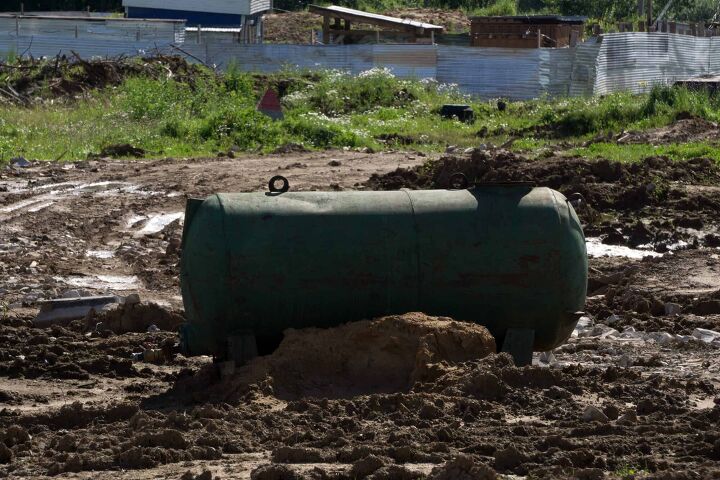The Pros and Cons of An Underground Propane Tank

Are you thinking about installing an underground propane tank? Propane is clean, efficient, and fairly inexpensive to use; underground propane tanks have many benefits, but they also come with risks. First, you need to know the pros and cons of underground propane tanks before you commit to buying.
Underground propane tanks are easy to install, provide more room in your yard, and keep your land looking neat. An underground propane tank is also less susceptible to damage from hazards in the open air. However, underground propane tanks also come with cons, including corrosion issues, geohazards, leaks, and increased damage from tree roots.
As you can see, you have a lot of information to consider before you make your choice. This article will provide you with the knowledge that you need to make a confident decision.
Do You Need a Heating and Cooling Contractor?
Get free, zero-commitment quotes from pro contractors near you.

Pros And Cons of Underground Propane Tanks
Before considering the pros and cons of underground propane tanks, decide whether having one is right for you. Several factors play into whether an underground propane tank setup is the best for your situation.
- Do you need a 500-gallon tank or more?
- Is your yard at least 12 feet by 5 feet?
- Is the area you want to install it away from traffic and the main road?
- Do you have a yard free of trees?
If you answered yes to any of those questions, an underground propane tank might be the right choice for you.
Pros Of Underground Propane Tanks
Underground Propane Tanks Are Easy To Install
The process is pretty involved. Although, for an underground propane tank, it’s relatively easy! You need to excavate the area for your tank. The critical part of excavation is to make sure it’s in the correct area.
Your propane tank needs to be 10 feet away from your home, at least. Also, it needs to be 10 feet away from your property line. Figuring out where to set your propane tank is the troublesome part of the installation. After that, it’s a breeze!
It should not take you longer than one day. It will take about 4 to 5 hours for installation.
Underground Propane Tanks Provide You With More Room in Your Yard
Another excellent benefit of an underground propane tank is the room you’ll have! The only difference will be a small hill in your yard, that’s it. You will have room for your animals, and your summer backyard parties. You’ll be able to do landscaping, and mow your lawn without the hassle.
The space of your yard is essential! Outdoors is where you do most of your gardening and landscaping. After you install your propane tank, you could even plant some flowers above it.
You might also have to regrow your grass, but that’s okay! That’s easy to do. However, code requirements won’t allow you to place anything like a patio, swing, child’s playset, or other items on top of the propane tank.
One idea is if you do plant some flowers above the tank, surround them with a short, decorative fence. A little fence will detour your family and pets away from the propane tank.
Allows You to Keep Your Land Attractive
No one wants a gigantic clunky piece of equipment just sitting in their yard. For one, it’s not attractive. Secondly, it will not contribute to the feeling of being in nature.
It’s nice to sit on a swing outside and read a book at the end of a long day. You can enjoy the gentle breeze and the beautiful scenery.
However, if you have a 500-gallon propane tank above ground? That’s going to throw off the good vibes you’re feeling; no one wants that. Plus, if your propane tank is above ground, it can be a hassle to maneuver around when you’re doing lawn care.
Keeps Your Tank Safe From Potential Hazards of the Open Air
Tanks above ground are relatively safe as well. However, they do not come without their risks. Some of the dangers are vandalism, vehicle collisions, and extreme climates.
A propane tank in the 100-degree sun is not a good idea. Heat can build up inside the tank causing the pressure relief valve to release propane. And with the cost of propane, that’s a real waste of propane and money.
But, when the tank is underground, it gets extra protection from the soil. This extra protection helps it regulate temperature better, making it less likely to waste propane.
Not to mention, if there is a leak, it’s more hazardous to you above ground than underground. Propane leaks can make you extremely sick. However, you’ll be able to spot a leak quicker above ground than you would underground.
Underground Propane Tanks Are Hard To Steal
You might not think your propane tank is high up on the list of items thieves target, but you’d be surprised. People steal propane tanks for the actual propane. But, people will also steal propane tanks to use in meth labs or to sell on the black market.
Since you typically don’ think to guard your propane tank, an above-ground tank becomes quite the easy target. But, if your tank is below ground, thieves can’t see it, so you likely don’t have to worry about theft.
Not to mention any burglar set on stealing a propane tank will head for the easier above-ground version and skip the one they need to dig up first.
Cons of Underground Propane Tanks
Corrosion Issues
Corrosion is the biggest threat to underground propane tanks. The risk of corrosion stems from the damp environment of the ground. Although there are some protective measures you can take. You could protect your propane with a protective covering called an anode bag.
The anode bag becomes corroded instead of your tank. However, you need to take care to replace the bag when it’s finished. If you don’t replace the bag, your propane tank will be the next target.
Geohazards
Geohazards is a short term for risks based on your geographical location. For instance, in California, a geohazard would be the earthquakes. Since the ground shifts, this could cause unwanted pressure on your propane tank.
A couple of other geohazards that threaten underground tanks placement are:
- Tsunamis
- Flooding
Both of these can knock your propane tank loose. If your tank becomes loose, you could end up with a floating tank, and it could stray away from your property. Even though this is an infrequent occurrence, it’s a good idea to be aware of it.
A floating tank can experience damage, twist supply lines, or cause damage to your lawn and property. Earthquakes are a more significant threat. You don’t want your tank to become warped over time; a warped tank is tough to remove safely.
Be sure to assess your area to ensure underground storage is a good option for you.
Leaks
Leaks are hazardous, especially when the tank is underground. Since you cannot see it, you may not notice that your tank is leaking at first.
The most noticeable sign you will notice is the smell. Propane has a powerful odor, fortunately. If you’re smelling propane, you need to check your tank. Underground tanks will have a strong odor if the leak is big. You must be very careful when digging the tank up.
The common causes of leaks are:
- Ground shifting
- Improper installation
- Corrosion
It is essential that you take the necessary precautions when installing the tank underground. That way, you lessen the likelihood of a leak happening in the first place.
Tree Roots
The way to prevent this is to keep your tank away from any trees. Tree roots tend to grow pretty far away from the tree itself.
Thankfully tree roots grow about 6 inches to 12 inches below the surface. It is easy to detect them. If the tree is more massive, the roots will be more prominent through the surface.
There are a few things to keep in mind when choosing a location:
- The taller the tree, the more extended the roots are. Try to stay at least 20 feet away from any large trees.
- Smaller trees still have roots that extend quite far.
- You can cut the roots away to install your propane tank.
If you decide to cut away the tree roots, just make sure you check them often. Tree roots multiply, and they are rather powerful.
Harder To Access
For obvious reasons, an underground propane tank isn’t as easy to service or access as one above the ground. But, if you get a quality tank at the outset, it should last you quite a while.
You shouldn’t have to worry about any frequent problems or malfunctioning. Although, depending on your tank’s size you typically need to get it recertified every 5 to 10 years.
Do You Need a Heating and Cooling Contractor?
Get free, zero-commitment quotes from pro contractors near you.

Related Questions
How long do propane tanks last underground?
Propane tanks can last upwards of 30 to 40 years underground. Of course, that’s with the correct care and placement. These tanks are known to be environmentally friendly.Take your time to ensure the correct setup and placement. That way, you have a tank that lasts for decades.
How much do underground propane tanks cost?
often another con of underground propane tanks is that they are more expensive, but the cost varies depending on the tank size. The tank costs anywhere from $500 to $3,500. If you’re self-installing, remember to calculate additional costs. The additional costs in this case are:
- An Anode bag
- Excavator
- Extra help of a friend
- Tools you may need
Now, if you plan on hiring a professional, that cost will increase. For professional installation of an underground propane tank, it will be anywhere from $1,700 to nearly $10,000.

Heather is a passionate writer who loves anything DIY. Growing up, she learned everything from home repairs to design, and wants to share her tips with you. When she's not writing, she's usually hiking or searching for her next DIY project.
More by Heather Robbins













![Finishing Basement Without Permit [Is It Really Illegal?]](https://cdn-fastly.upgradedhome.com/media/2023/07/31/9070078/finishing-basement-without-permit-is-it-really-illegal.jpg?size=350x220)







![12 Washing Machine Brands to Avoid [with Recall Data]](https://cdn-fastly.upgradedhome.com/media/2023/07/31/9075781/12-washing-machine-brands-to-avoid-with-recall-data.jpg?size=350x220)





